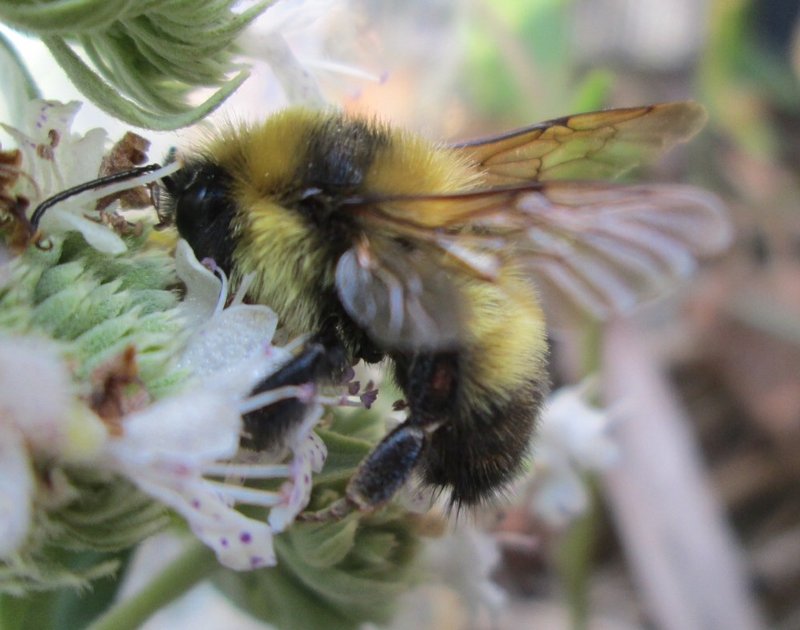Honey Bees and Native Bees

Kim Fellows
These anecdotes are common, and reflect the misinformation that is perhaps inevitable in a complex subject – pollinator conservation. The honey bee has recently been featured in global headlines about its population declines, largely due to disease, pesticides and habitat loss. But the honey bee is just one of 20,000 species of bees found around the world. Here in North America, we have about 4000 species of native bees. The honey bee is the only one of these that makes honey and beeswax in harvestable quantities, which is perhaps partly why urban beekeeping has become a trendy hobby, and is often thought of as a way to “save the bees.”
The honey bee is not native to North America. It arrived here with the colonists, about 400 years ago. And honey bees are not at risk of extinction, according to the Red List criteria of the International Union for Conservation of Nature. However, six of our native Canadian bees are listed as being at risk, and one – the Rusty-patched bumble bee – is listed as endangered. There is a paucity of data to further assess the majority of our native bees.
Two Canadian scientists, Sheila Colla from York University and Scott MacIvor from the University of Toronto, argue that honey bee losses are less of a conservation problem than they are a domesticated animal management issue. They are more concerned with ways to conserve native bees, and are worried that the current focus on the honey bee is undermining native pollinator conservation. In particular, they argue that beekeepers are increasingly given access to natural areas, often without prior environmental impact assessments or ongoing monitoring of native bee communities, and such habitats are usually high in native bee diversity.
Colla and MacIvor point out that a honey bee colony is typically composed of 50,000 - 60,000 bees at the peak of summer, which dwindles to 20,000 - 30,000 in the off-season. Such large colonies are capable of intense resource competition with any native bees that already forage in the same area. The Canadian Honey Council says that bees must visit over 2.6 million flowers in order to make one pound of honey. And according to Julie Zahniser of the Forage and Nutrition NAPPC Task Force, a review of scientific papers suggests that one honey bee colony needs at least four to five acres of constantly blooming flowers to sustain itself. That estimate may be conservative.
So when urban residents take up beekeeping, often without prior experience, the number of bees that need to be fed, as well as the risk of bee diseases, also increases, threatening native bee populations. You can see an example of how much more food and habitat a few new hives in Toronto would need in this series of tweets. Perhaps cities with existing hives might collaborate to form co-operatives, such as the Toronto Beekeepers Collective, instead of expanding the number of hives. This way, people truly intrigued with honey bees can get involved in beekeeping, without increasing the number of hives in an area. And perhaps more importantly, new beekeepers can be mentored and properly trained in the process.
Honey bees are indeed wondrous creatures that help pollinate many agricultural crops, produce wax and honey, and, like other pollinators, are facing a number of threats, for which they are rightly getting media attention. But for most of us, especially those of us who live in urban settings, the best thing we can do is to use that momentum to introduce ourselves to native bees that need protection.
And what is the best thing we can do to “save the bees”? It’s plant for them. We can ensure there is a continuous bloom, from early spring to late autumn, of native plants that offer bee food (nectar and pollen). And while bees accomplish most of the pollination services we need, other native pollinators, such as butterflies, moths, beetles and wasps, are also important. The more native plant diversity we can offer all these creatures, the more pollinator diversity we will get to enjoy.
**
Kim Fellows is the Outreach Coordinator for Pollination Canada.
Photo: Red-belted bumble bee (Bombus rufocinctus) on hairy mountain mint (Pycnanthemum pilosum), Kitchener, ON.
This article was revised on December 6, 2017 to clarify the idea that instead of increasing the number of honey bee hives in an urban center, organizations and hobbyists with existing hives might form cooperatives to open the door to citizens who are interested in beekeeping. We would like to emphasize that taking up the hobby of urban beekeeping is not a way to "save the bees," but we gratefully recognize that people are moved to answer that call to action. The best action to help bees is to plant for them.
Not yet a member?
An annual membership to Seeds of Diversity gives you access to our seed exchange, seed grow-out programs, and our online news.

We depend on donations to do our work.

Thank you for your support!
